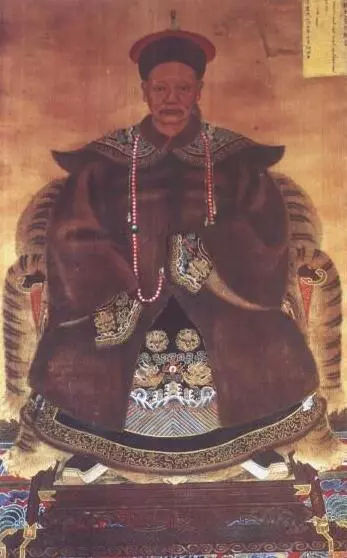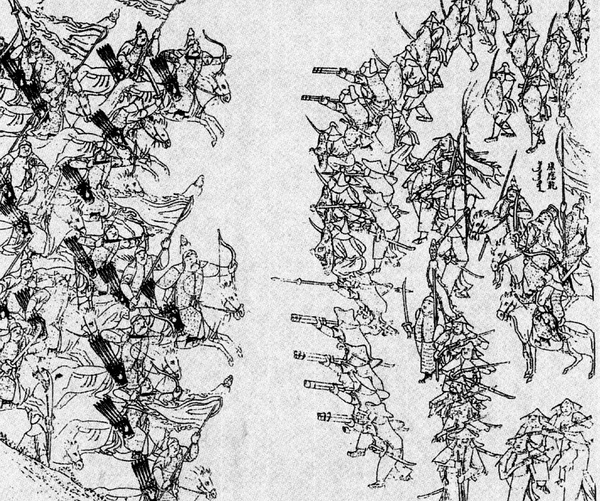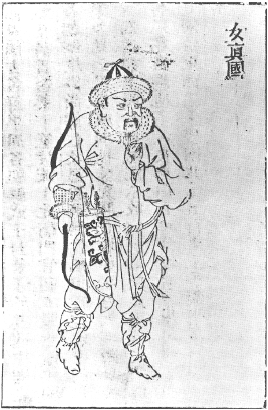|
Prince Wen
Prince Wen of the Second Rank, or simply Prince Wen, was the title of a princely peerage used in China during the Manchu-led Qing dynasty (1644–1912). As the Prince Wen peerage was not awarded "iron-cap" status, this meant that each successive bearer of the title would normally start off with a title downgraded by one rank ''vis-à-vis'' that held by his predecessor. However, the title would generally not be downgraded to any lower than a ''feng'en fuguo gong'' except under special circumstances. The first bearer of the title was Mengguan (猛瓘; 1643–1674), Hooge's fifth son and a great-grandson of Nurhaci (the founder of the Qing dynasty). In 1657, Mengguan was granted the title "Prince Wen of the Second Rank" by the Shunzhi Emperor. The title was passed down over three generations and held by five persons. Members of the Prince Wen peerage * Mengguan (猛瓘; 1643 – 1674; 1st), Hooge's fifth son, held the title Prince Wen of the Second Rank from 1657 to 1674, po ... [...More Info...] [...Related Items...] OR: [Wikipedia] [Google] [Baidu] |
Royal And Noble Ranks Of The Qing Dynasty
The Qing dynasty (1644–1912) of China developed a complicated peerage system for royal and noble ranks. Rule of inheritance In principle, titles were downgraded one grade for each generation of inheritance. * Direct imperial princes with the ''Eight Privileges'' were downgraded for four generations, after which the title can be inherited without further downgrades. * Direct imperial princes without the ''Eight Privileges'' were downgraded until the rank of ''feng'en jiangjun'', which then became perpetual. * Cadet line imperial princes and lords were downgraded until they reached ''feng'en jiangjun'', which could be further inherited three times before the title expired completely. * For non-imperial peers, the title could be downgraded to ''en jiwei'' before becoming perpetually heritable. Occasionally, a peer could be granted the privilege of ''shixi wangti'' ( zh, t=世襲罔替, p=shìxí wǎngtì, labels=no; "perpetual heritability"), which allowed the title to be p ... [...More Info...] [...Related Items...] OR: [Wikipedia] [Google] [Baidu] |
Manchu People
The Manchus (; ) are a Tungusic peoples, Tungusic East Asian people, East Asian ethnic group native to Manchuria in Northeast Asia. They are an officially recognized Ethnic minorities in China, ethnic minority in China and the people from whom Manchuria derives its name. The Later Jin (1616–1636), Later Jin (1616–1636) and Qing dynasty, Qing (1636–1912) dynasties of China were established and ruled by the Manchus, who are descended from the Jurchen people who earlier established the Jin dynasty (1115–1234), Jin dynasty (1115–1234) in northern China. Manchus form the largest branch of the Tungusic peoples and are distributed throughout China, forming the fourth largest ethnic group in the country. They are found in 31 Chinese provincial regions. Among them, Liaoning has the largest population and Hebei, Heilongjiang, Jilin, Inner Mongolia and Beijing have over 100,000 Manchu residents. About half of the population live in Liaoning and one-fifth in Hebei. There are a ... [...More Info...] [...Related Items...] OR: [Wikipedia] [Google] [Baidu] |
Qing Dynasty
The Qing dynasty ( ), officially the Great Qing, was a Manchu-led Dynasties of China, imperial dynasty of China and an early modern empire in East Asia. The last imperial dynasty in Chinese history, the Qing dynasty was preceded by the Ming dynasty and succeeded by the Republic of China (1912–1949), Republic of China. At its height of power, the empire stretched from the Sea of Japan in the east to the Pamir Mountains in the west, and from the Mongolian Plateau in the north to the South China Sea in the south. Originally emerging from the Later Jin (1616–1636), Later Jin dynasty founded in 1616 and proclaimed in Shenyang in 1636, the dynasty seized control of the Ming capital Beijing and North China in 1644, traditionally considered the start of the dynasty's rule. The dynasty lasted until the Xinhai Revolution of October 1911 led to the abdication of the last emperor in February 1912. The multi-ethnic Qing dynasty Legacy of the Qing dynasty, assembled the territoria ... [...More Info...] [...Related Items...] OR: [Wikipedia] [Google] [Baidu] |
Aisin Gioro
The House of Aisin-Gioro is a Manchu clan that ruled the Later Jin dynasty (1616–1636), the Qing dynasty (1636–1912), and Manchukuo (1932–1945) in the history of China. Under the Ming dynasty, members of the Aisin Gioro clan served as chiefs of the Jianzhou Jurchens, one of the three major Jurchen tribes at this time. Qing bannermen passed through the gates of the Great Wall in 1644, and eventually conquered the short-lived Shun dynasty, Xi dynasty and Southern Ming dynasty. After gaining total control of China proper, the Qing dynasty later expanded into other adjacent regions, including Xinjiang, Tibet, Outer Mongolia, and Taiwan. The dynasty reached its zenith during the High Qing era and under the Qianlong Emperor, who reigned from 1735 to 1796. This reign was followed by a century of gradual decline. The house lost power in 1912 following the Xinhai Revolution. Puyi, the last Aisin-Gioro emperor, nominally maintained his imperial title in the Forbidden City un ... [...More Info...] [...Related Items...] OR: [Wikipedia] [Google] [Baidu] |
Hooge (prince)
Hooge (Manchu language, Manchu: ; 16 April 1609 – 4 May 1648), formally known as Prince Su, was a Manchu people, Manchu prince of the Qing dynasty. He was the eldest son of Hong Taiji, the second ruler of the Qing dynasty. Life Hooge was born in the Aisin Gioro clan as the eldest son of Hong Taiji, the second ruler of the Qing dynasty. His mother was Lady Ula Nara, one of Hong Taiji's consorts. Hooge participated in military campaigns against the Mongols, Koreans and the Ming dynasty. After Hong Taiji's death in 1643, Hooge and his uncle Dorgon fought over the succession to the throne. The situation was to Hooge's advantage because three of the Eight Banners previously under Hong Taiji's control had been passed on to him. On the other hand, Dorgon had the support of his brothers and two White Banners. This meant that the remaining two Red Banners controlled by Daišan and his son, as well as the Bordered Blue Banner under Chiurhala, were crucial to ensuring that Hooge could w ... [...More Info...] [...Related Items...] OR: [Wikipedia] [Google] [Baidu] |
Nurhaci
Nurhaci (14 May 1559 – 30 September 1626), also known by his temple name as the Emperor Taizu of Qing, was the founding khan of the Jurchen people, Jurchen-led Later Jin (1616–1636), Later Jin dynasty. As the leader of the House of Aisin-Gioro, Nurhaci reorganized and united various Jurchen tribes (the later "Manchu people, Manchu"), consolidated the Eight Banners military system, and eventually launched attacks on both the Ming dynasty, Ming and Joseon dynasties. His conquest of Ming dynasty's northeastern Liaodong region laid the groundwork for the Qing conquest of the Ming by his descendants, who proclaimed the Qing dynasty in 1636. He is also generally credited with ordering the creation of a new written script for the Manchu language based on the Mongolian script, Mongolian vertical script. Name and titles Nurhaci is written as in Manchu language. Some suggest that the meaning of the name in the Manchu language is "the skin of a wild boar". Another explanation is "brav ... [...More Info...] [...Related Items...] OR: [Wikipedia] [Google] [Baidu] |
Shunzhi Emperor
The Shunzhi Emperor (15 March 1638 – 5 February 1661), also known by his temple name Emperor Shizu of Qing, personal name Fulin, was the second Emperor of China, emperor of the Qing dynasty, and the first Qing emperor to rule over China proper. Upon the death of his father Hong Taiji, a Deliberative Council of Princes and Ministers, committee of Manchu princes chose the 5-year-old Fulin as successor. The princes also appointed two co-regents: Dorgon, the 14th son of Nurhaci, and Jirgalang, one of Nurhaci's nephews, both of whom were members of the Qing imperial clan. In November 1644, the Shunzhi Emperor was enthroned as emperor of China in Beijing. From 1643 to 1650, political power lay mostly in the hands of the prince regent Dorgon. Under his leadership, the Qing conquered most of the territory of the fallen Ming dynasty, chased Southern Ming, Ming loyalist regimes deep into the southwestern provinces, and established the basis of Qing rule over China proper despite highl ... [...More Info...] [...Related Items...] OR: [Wikipedia] [Google] [Baidu] |
Mengguan
Mengguan (猛瓘; 21 December 1643 – 12 August 1674In most sources the name is written as Meng'e (猛峨)) was Qing dynasty imperial prince as the fifth son of Hooge, Prince Su, Hong Taiji's grandson and a cousin of Kangxi Emperor. Mengguan was the first Prince Wen of the Second Rank since 1657. The peerage was not granted perpetual inheritability which meant that his successors would hold diminished ranks. However, the peerage was abolished because Mengguan's son Yanxin was convicted of collaboration with Yunsi. Life Mengguan was born to Hooge's secondary princess consort, lady Shuolongwu. Mengguan was raised in the imperial palace since young after he had been noticed by the Empress Xiaoduanwen. The empress had held Mengguan on her arms, sat with him on the chair and ordered Fushou to help her keep watch on Mengguan. When other princes came to attend court session, Prince Li Daišan was startled seeing the empress carefully holding the newborn. Also Dorgon and Jirgalang e ... [...More Info...] [...Related Items...] OR: [Wikipedia] [Google] [Baidu] |
Prince Su
Prince Su of the First Rank (Manchu: ; ''hošoi fafungga cin wang''; ), or simply Prince Su (), was the title of a princely peerage of the Manchu-led Qing dynasty of China (1644–1912). It was also one of the 12 "iron-cap" princely peerages in the Qing dynasty, which meant that the title could be passed down without being downgraded. The first bearer of the title was Hooge (1609–1648), the eldest son of Hong Taiji, the founding emperor of the Qing dynasty. He was awarded the title in 1636 by his father. The peerage was renamed to Prince Xian of the First Rank (Prince Xian) when it was passed on to Hooge's son, Fushou (died 1669), in 1651. It was also given "iron-cap" status later on. In 1778, when Yunzhu (died 1778) was holding the title, the Qianlong Emperor renamed it back to "Prince Su of the First Rank". The peerage was passed down over ten generations and held by 11 persons – eight as Prince Su, and three as Prince Xian. Members of the Prince Su / Prince Xian peera ... [...More Info...] [...Related Items...] OR: [Wikipedia] [Google] [Baidu] |
Draft History Of Qing
The ''Draft History of Qing'' () is a draft of the official history of the Qing dynasty compiled and written by a team of over 100 historians led by Zhao Erxun who were hired by the Beiyang government of the Republic of China. The draft was published in 1928, but the Chinese Civil War caused a lack of funding for the project and it was put to an end in 1930. The two sides of the Chinese civil war, the People's Republic of China and Republic of China have attempted to complete it. History The Qing imperial court had previously established a Bureau of State Historiography that pre-compiled its own dynastic history. The massive book was started in 1914, and the rough copy was finished in about 1927. 1,100 copies of the book were published. The Beiyang government moved 400 of the original draft into the northern provinces, where it re-edited the content twice, thus creating three different versions of the book. It was banned by the Nationalist Government in 1930. The ban was lift ... [...More Info...] [...Related Items...] OR: [Wikipedia] [Google] [Baidu] |



